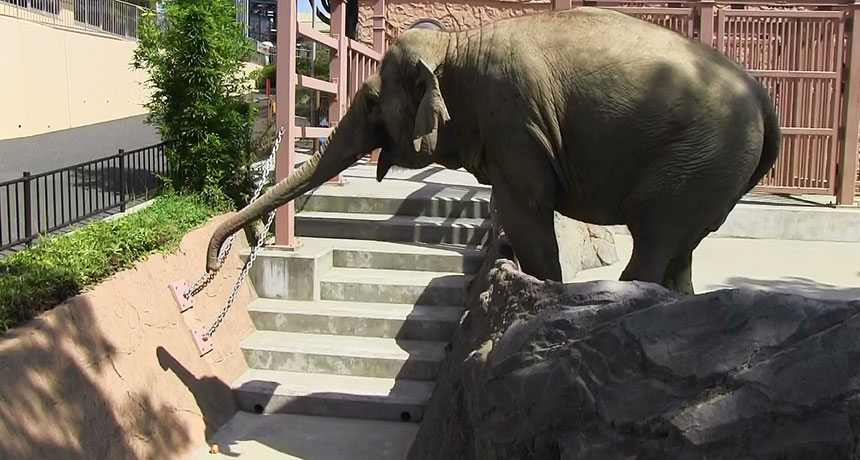Elephants’ trunks: These leaf-blowers snag food
Clever animals aimed blasts of air at out-of-reach fruit to move it close enough to grab

Researchers placed apples and other treats just out reach of two elephants at Kamine Zoo in Japan. The elephants directed puffs of air behind the food to pull it closer so they could grab it.
Kaori Mizuno
Food can be a great motivator. That’s true whether you’re a kid with a sweet tooth or an elephant with a taste for fresh fruit. And just like people, animals often get quite creative when they’re in the mood for a meal or treat. Crows will turn sticks into tools to reach bugs. Chimpanzees will use stones as hammers to crack open nuts. Archerfish will shoot jets of spit to knock an insect off a leaf. Now a video shows Asian elephants using cleverly aimed puffs of air to move apples, leaves and other food close enough to grab and eat.
Kaori Mizuno and colleagues at the Graduate University for Advanced Studies in Hayama, Japan, caught the behavior on video. They worked with two female Asian elephants, Mineko and Suzuko. Both elephants lived at the Kamine Zoo. It’s in Japan’s Ibaraki Prefecture. In 2011, Mizuno had observed Mineko blowing with her trunk to obtain food. She and her colleagues decided to look more closely at the behavior.
The two elephants live in an enclosure that is surrounded by a U-shaped ditch that the animals cannot enter or cross. The ditch is just shallow enough that an elephant can reach an object on the bottom with its trunk. But it can’t reach an object on the far side of this moat. This let Mizuno’s team set up a challenge for the animals. They regularly set out tasty treats — apples, bamboo, hay, potatoes or fallen leaves — on the far side of the ditch. They then recorded what the elephants did.
BLOWN AWAY Two female Asian elephants, Mineko and Suzuko, were caught on video using their trunks as leaf-blowers to drag food to where they could reach it. The behavior shows the animals understand causality, researchers say. Kaori Mizuno |
Both elephants were caught on film blowing their trunks to draw the food closer. Each would reach out her trunk, aim backwards a bit and then blow out a few puffs of air. That drove the food close enough to grab. Mineko was the master — she used fewer puffs, blew longer and aimed better than Suzuko. Suzuko sometimes got her food only just close enough that she could grab it if she raised one of her rear legs for balance.
Mizuno’s team described these findings November 5 in Animal Cognition.
This wasn’t the first time such behavior has been recorded. Charles Darwin, the English scientist known for his theory of how species evolve, made a similar observation. In 1874, he wrote in his book The Descent of Man:
I have seen, as I daresay have others, that when a small object is thrown on the ground beyond the reach of one of the elephants in the Zoological Gardens, he blows through his trunk on the ground beyond the object, so that the current reflected on all sides may drive the object within his reach.
Scientists once believed that only humans use tools. Now that it’s clear that’s not true, it’s worth looking at the elephants’ behavior again. Is trunk-blowing considered tool use? The classic definition of a tool is “the external employment of an unattached environmental object.” In other words, a tool is an object that is not attached to the animal. Air is not an “object,” so it may not qualify. Neither would the archerfish’s water jet. But what may be more important to consider is the thinking, or cognitive, processes that drive the behavior, Mizuno and colleagues say.
“Our results suggest that elephants seem to understand causality and physical reasoning,” they write. By causality, they are referring to the idea that one action causes another. Physical reasoning refers to animals’ ability to understand the existence and behavior of objects in the world around them.
The researchers are unsure how the elephants picked up this leaf-blower behavior. They might have stumbled upon the trick by accident. Or maybe they solved the problem more purposely. Either way, the fact that two females living together are both showing the same behavior suggests that one elephant may have learned it from the other. Scientists call that social learning.
Perhaps other elephants can learn the behavior. And let’s hope so. After all, elephant leaf blowers might be a lot better sounding, and more entertaining, than the gas-powered ones that drown out nature every fall.
Power Words
(for more about Power Words, click here)
behavior The way a person or other organism acts towards others, or conducts itself.
causality The idea that one action causes another.
cognitive A term that relates to mental activities, such as thinking, learning, remembering and solving puzzles
evolve (adj. evolving) To change gradually over generations, or a long period of time. In living organisms, the evolution usually involves random changes to genes that will then be passed along to an individual’s offspring. These can lead to new traits, such as altered coloration, new susceptibility to disease or protection from it, or different shaped features (such as legs, antennae, toes or internal organs).
motivator A thing, event or idea that encourages an animal (or human) to behave or act in a particular way.
physical reasoning The ability to understand the existence and behavior of objects in the world.
social learning A type of learning in which individuals observe the behavior of others and modify their own behavior based on what they see.
species A group of similar organisms capable of producing offspring that can survive and reproduce.
tool An object that a person or other animal makes or obtains and then uses to carry out some purpose such as reaching food, defending itself or grooming.







